Recognition Site Modifiable Macrocycle: Synthesis, Functional Group Variation and Structural Inspection
Abstract
1. Introduction
2. Results and Discussion
3. Materials and Methods
3.1. General Information
3.2. Preparation of 2-Methoxy-2-oxoethyl 4-hydroxy-3,5-dinitrobenzoate (2)
3.3. Preparation of 2-Methoxy-2-oxoethyl 3,5-diamino-4-hydroxybenzoate (3)
3.4. Preparation of the Diester (7)
3.5. Preparation of the Diacid (8)
3.6. Synthesis of the Macrocycle (9)
3.7. Synthesis of the Macrocycle (10)
3.8. Synthesis of the Macrocycle (11)
3.9. Synthesis of the Macrocycle (12)
3.10. Synthesis of the Macrocycle (13)
3.11. 1H NMR, 13C{1H} NMR, Mass, 1H-1H COSY and 1H-1H NOESY NMR Spectra
4. Conclusions
Supplementary Materials
Author Contributions
Funding
Institutional Review Board Statement
Informed Consent Statement
Data Availability Statement
Conflicts of Interest
Sample Availability
References
- Quiocho, A.F. Protein-carbohydrate interactions: Basic molecular features. Pure Appl. Chem. 1989, 61, 1293–1306. [Google Scholar] [CrossRef]
- Toone, J.E. Structure and energetic of protein-carbohydrate complexes. Curr. Opin. Struct. Biol. 1994, 4, 719–728. [Google Scholar] [CrossRef]
- Wimmerova, M.; Mitchell, E.; Sanchez, J.-F.; Gautier, C.; Imberty, A. Crystal Structure of Fungal Lectin six-bladed β-propeller fold and novel fucose recognition mode for aleuria aurantia lectin. J. Biol. Chem. 2003, 278, 27059–27067. [Google Scholar] [CrossRef] [PubMed]
- Maresso, W.A.; Schneewind, O. Sortase as a Target of Anti-Infective Therapy. Pharmacol. Rev. 2008, 60, 128–141. [Google Scholar] [CrossRef] [PubMed]
- Clancy, W.K.; Melvin, A.J.; McCafferty, G.D. Sortase transpeptidases: Insights into mechanism, substrate specificity, and inhibition. Peptide Sci. 2010, 94, 385–396. [Google Scholar] [CrossRef]
- Pishesha, N.; Ingram, R.J.; Ploegh, L.H. Sortase A: A Model for Transpeptidation and Its Biological Applications. Annu. Rev. Cell Dev. Biol. 2018, 34, 163–188. [Google Scholar] [CrossRef]
- Gellman, S.H. Foldamers: A manifesto. Acc. Chem. Res. 1998, 31, 173–180. [Google Scholar] [CrossRef]
- Zhang, D.-W.; Zhao, X.; Hou, J.-L.; Li, Z.-T. Aromatic Amide Foldamers: Structures, Properties, and Functions. Chem. Rev. 2012, 112, 5271–5316. [Google Scholar] [CrossRef]
- Azzarito, V.; Long, K.; Murphy, N.S.; Wilson, A.J. Inhibition of α-helix-mediated protein–protein interactions using designed molecules. Nat. Chem. 2013, 5, 161–173. [Google Scholar] [CrossRef]
- Chandramouli, N.; Ferrand, Y.; Lautrette, G.; Kauffmann, B.; Mackereth, D.C.; Laguerre, M.; Dubreuil, D.; Huc, I. Iterative design of a helically folded aromatic oligoamide sequence for the selective encapsulation of fructose. Nat. Chem. 2015, 7, 334–341. [Google Scholar] [CrossRef]
- Hu, X.; Dawson, J.S.; Nagaoka, Y.; Tanatani, A.; Huc, I. Solid-Phase Synthesis of Water-Soluble Helically Folded Hybrid α-Amino Acid/Quinoline Oligoamides. J. Org. Chem. 2016, 81, 1137–1150. [Google Scholar] [CrossRef] [PubMed]
- Zhang, Y.; Zhong, Y.; Connor, L.A.; Miller, P.D.; Cao, R.; Shen, J.; Song, B.; Baker, S.E.; Tang, Q.; Pulavarti, V.S.R.K.S.; et al. Folding and Assembly of Short α, β, γ-Hybrid Peptides: Minor Variations in Sequence and Drastic Differences in Higher-Level Structures. J. Am. Chem. Soc. 2019, 141, 14239–14248. [Google Scholar] [CrossRef] [PubMed]
- Li, D.; Ma, C.; Xiang, J.; Zhang, K.; Yang, L.; Gan, Q. A Disulfide Switch Providing Absolute Handedness Control in Double Helices via Conversion from the Antiparallel to Parallel Helical Pattern. Chem. Eur. J. 2021, 27, 11663–11669. [Google Scholar] [CrossRef]
- Jeong, S.; Zhang, L.; Kim, J.; Gong, J.; Choi, J.; Ok, K.M.; Lee, Y.; Kwon, S.; Lee, H.-S. Conformational Adaptation of b-Peptide Foldamers for the Formation of Metal–Peptide Frameworks. Angew. Chem. Int. Ed. 2022, 61, e202108364. [Google Scholar]
- Yoo, H.S.; Buratto, J.; Roy, A.; Morvan, E.; Pasco, M.; Pulka-Ziach, K.; Lombardo, M.C.; Rosu, F.; Gabelica, V.; Mackereth, D.C.; et al. Adaptive Binding of Alkyl Glycosides by Nonpeptidic Helix Bundles in Water: Toward Artificial Glycolipid Binding Proteins. J. Am. Chem. Soc. 2022, 144, 15988–15998. [Google Scholar] [CrossRef]
- Gokel, W.G.; Leevy, W.M.; Weber, E.M. Crown Ethers: Sensors for Ions and Molecular Scaffolds for Materials andBiological Models. Chem. Rev. 2004, 104, 2723–2750. [Google Scholar] [CrossRef]
- Lagona, J.; Mukhopadhyay, P.; Chakrabarti, S.; Isaacs, L. The Cucurbit[n]uril Family. Angew. Chem. Int. Ed. 2005, 44, 4844–4870. [Google Scholar] [CrossRef]
- Lee, S.; Chen, C.-H.; Flood, H.A. A pentagonal cyanostar macrocycle with cyanostilbene CH donors binds anions and forms dialkylphosphate [3]rotaxanes. Nat. Chem. 2013, 5, 704–710. [Google Scholar] [CrossRef]
- Basilotta, R.; Mannino, D.; Filippone, A.; Casili, G.; Prestifilippo, A.; Colarossi, L.; Raciti, G.; Esposito, E.; Campolo, M. Role of Calixarene in Chemotherapy Delivery Strategies. Molecules 2021, 26, 3963. [Google Scholar] [CrossRef]
- Lebrón, A.J.; López-López, M.; García-Calderón, B.C.; Rosado, V.I.; Balestra, R.F.; Huertas, P.; Rodik, V.R.; Kalchenko, I.V.; Bernal, E.; Moyá, L.M.; et al. Multivalent Calixarene-Based Liposomes as Platforms for Gene and Drug Delivery. Pharmaceutics 2021, 13, 1250. [Google Scholar] [CrossRef]
- Wu, J.-R.; Wu, G.; Yang, Y.-W. Pillararene-Inspired Macrocycles: From Extended Pillar[n]arenes to Geminiarenes. Acc. Chem. Res. 2022, 55, 3191–3204. [Google Scholar] [CrossRef] [PubMed]
- Chen, X.-Y.; Chen, H.; Stoddart, F. The Story of the Little Blue Box: A Tribute to Siegfried Hünig. Angew. Chem. Int. Ed. 2023, 62, e202211387. [Google Scholar] [CrossRef] [PubMed]
- Ahmad, N.; Younus, A.H.; Chughtai, H.A.; Verpoort, F. Metal–organic molecular cages: Applications of biochemical implications. Chem. Soc. Rev. 2015, 44, 9–25. [Google Scholar] [CrossRef]
- Gan, Q.; Ronson, T.K.; Vosburg, D.A.; Thoburn, J.D.; Nitschke, J.R. Cooperative Loading and Release Behavior of a Metal−Organic Receptor. J. Am. Chem. Soc. 2015, 137, 1770–1773. [Google Scholar] [CrossRef] [PubMed]
- Davis, A.P. Biomimetic carbohydrate recognition. Chem. Soc. Rev. 2020, 49, 2531–2545. [Google Scholar] [CrossRef]
- Tapia, L.; Alfonso, I.; Solà, J. Molecular cages for biological applications. Org. Biomol. Chem. 2021, 19, 9527–9540. [Google Scholar] [CrossRef]
- Montà-González, G.; Sancenón, F.; Martínez-Máñez, R.; Martí-Centelles, V. Purely Covalent Molecular Cages and Containers for Guest Encapsulation. Chem. Rev. 2022, 122, 13636–13708. [Google Scholar] [CrossRef]
- Kim, Y.-H.; Hong, J.-I. Molecular Recognition of Carbohydrates through Directional Hydrogen Bonds by Urea-Appended Porphyrins in Organic Media. Angew. Chem. Int. Ed. 2002, 41, 2947–2950. [Google Scholar] [CrossRef]
- Nativi, C.; Cacciarini, M.; Francesconi, O.; Vacca, A.; Moneti, G.; Ienco, A.; Roelens, S. Pyrrolic Tripodal Receptors Effectively Recognizing Monosaccharides. Affinity Assessment through a Generalized Binding Descriptor. J. Am. Chem. Soc. 2007, 129, 4377–4385. [Google Scholar] [CrossRef]
- Zysman-Colman, E.; Denis, C. Inorganic and organometallic hemicagepodates and cage cryptates incorporating a benzene platform. Coordin. Chem. Rev. 2012, 256, 1742–1761. [Google Scholar] [CrossRef]
- Rohini; Baral, M.; Kanungo, B.K. Comparative studies of the electronic, bindingand photophysical properties of a new nona-dentate hemi-cage tripodal HQ pendanttrizaza-macrocycle with unfilled, half-filled and completely filled lanthanide ions. New J. Chem. 2018, 42, 16040–16059. [Google Scholar] [CrossRef]
- He, Y.; Mao, C.; Duan, M.; Fan, L.; Wang, X.; Cai, Y.; Du, M.; Hu, M.; Hu, P.; Cheng, Q.; et al. Rescuing the solid-state fluorescence of perylenediimide dyes by host–guest isolation. Org. Chem. Front. 2022, 9, 6466–6474. [Google Scholar] [CrossRef]
- Yu, X.; Sun, D. Macrocyclic Drugs and Synthetic Methodologies toward Macrocycles. Molecules 2013, 18, 6230–6268. [Google Scholar] [CrossRef] [PubMed]
- Surur, A.S.; Sun, D. Macrocycle-Antibiotic Hybrids: A Path to Clinical Candidates. Front. Chem. 2021, 9, 659845. [Google Scholar] [CrossRef] [PubMed]
- Zorzi, A.; Deyle, K.; Heinis, C. Cyclic peptide therapeutics: Past, present and future. Curr. Opin. Chem. Biol. 2017, 38, 24–29. [Google Scholar] [CrossRef]
- Carbonnelle, A.-C.; Zhu, J. A Novel Synthesis of Biaryl-Containing Macrocycles by a Domino Miyaura Arylboronate Formation: Intramolecular Suzuki Reaction. Org. Lett. 2000, 2, 3477–3480. [Google Scholar] [CrossRef]
- Meyer, F.-M.; Collins, J.C.; Borin, B.; Bradow, J.; Liras, S.; Limberakis, C.; Mathiowetz, A.M.; Philippe, L.; Price, D.; Song, K..; et al. Biaryl-Bridged Macrocyclic Peptides: Conformational Constraint via Carbogenic Fusion of Natural Amino Acid Side Chains. J. Org. Chem. 2012, 77, 3099–3114. [Google Scholar] [CrossRef]
- Speicher, A.; Backes, T.; Hesidens, K.; Kolz, J. Ring strain and total syntheses of modified macrocycles of the isoplagiochin type. Beilstein J. Org. Chem. 2009, 5, 71. [Google Scholar] [CrossRef]
- Sun, D. Recent Advances in Macrocyclic Drugs and Microwave-Assisted and/or Solid-Supported Synthesisof Macrocycles. Molecules 2022, 27, 1012. [Google Scholar] [CrossRef]
- Ben-Lulu, M.; Gaster, E.; Libman, A.; Pappo, D. Synthesis of Biaryl-Bridged Cyclic Peptides via Catalytic OxidativeCross-Coupling Reactions. Angew. Chem. Int. Ed. 2020, 59, 4835–4839. [Google Scholar] [CrossRef]
- Mandal, P.K.; Kauffmann, B.; Destecroix, H.; Ferrand, Y.; Davis, A.P.; Huc, I. Crystal structure of a complex between β-glucopyranose and a macrocyclic receptor with dendritic multicharged water solubilizing chains. Chem. Commun. 2016, 52, 9355–9358. [Google Scholar] [CrossRef] [PubMed]
- Stewart, P.; Renney, C.M.; Mooibroek, T.J.; Ferheena, S.; Davis, A.P. Maltodextrin recognition by a macrocyclic synthetic lectin. Chem. Commun. 2018, 54, 8649–8652. [Google Scholar] [CrossRef] [PubMed]
- Van Eker, D.; Samanta, S.K.; Davis, A.P. Aqueous recognition of purine and pyrimidine bases by an anthracene-based macrocyclic receptor. Chem. Commun. 2020, 56, 9268–9271. [Google Scholar] [CrossRef]
- Wu, G.; Clarke, E.D.; Wu, C.; Scherman, A.O. Oligopeptide-CB[8] complexation with switchable binding pathways. Org. Biomol. Chem. 2019, 17, 3514–3520. [Google Scholar] [CrossRef] [PubMed]
- Hu, X.-B.; Chen, Z.; Tang, G.; Hou, J.-L.; Li, Z.-T. Single-Molecular Artificial Transmembrane Water Channels. J. Am. Chem. Soc. 2012, 134, 8384–8387. [Google Scholar] [CrossRef]
- Baumes, M.J.; Gassensmith, J.J.; Giblin, J.; Lee, J.-J.; White, G.A.; Culligan, J.W.; Leevy, M.; Kuno, M.; Smith, D.B. Storable, thermally activated, near-infrared chemiluminescent dyes and dye-stained microparticles for optical imaging. Nat. Chem. 2010, 2, 1025–1030. [Google Scholar] [CrossRef]
- Li, S.; Gao, Y.; Ding, Y.; Xu, A.; Tan, H. Supramolecular nano drug delivery systems mediated via host-guest chemistry of cucurbit[n]uril (n = 6 and 7). Chin. Chem. Lett. 2021, 32, 313–318. [Google Scholar] [CrossRef]
- Maltceva, O.; Mamardashvili, G.; Khodov, I.; Lazovskiy, D.; Khodova, V.; Krest’yaninov, M.; Mamardashvili, N.; Dehaen, W. Molecular recognition of nitrogen-containing bases by Zn[5,15-bis-(2,6-dodecyloxyphenyl)]porphyrin. Supramol. Chem. 2017, 29, 360–369. [Google Scholar] [CrossRef]
- Imai, H.; Nakagawa, S.; Kyuno, E. Recognition of Axial Ligands by a Zinc Porphyrin Host on the Basis of Nonpolar Interligand Interaction. J. Am. Chem. Soc. 1992, 114, 6719–6723. [Google Scholar] [CrossRef]
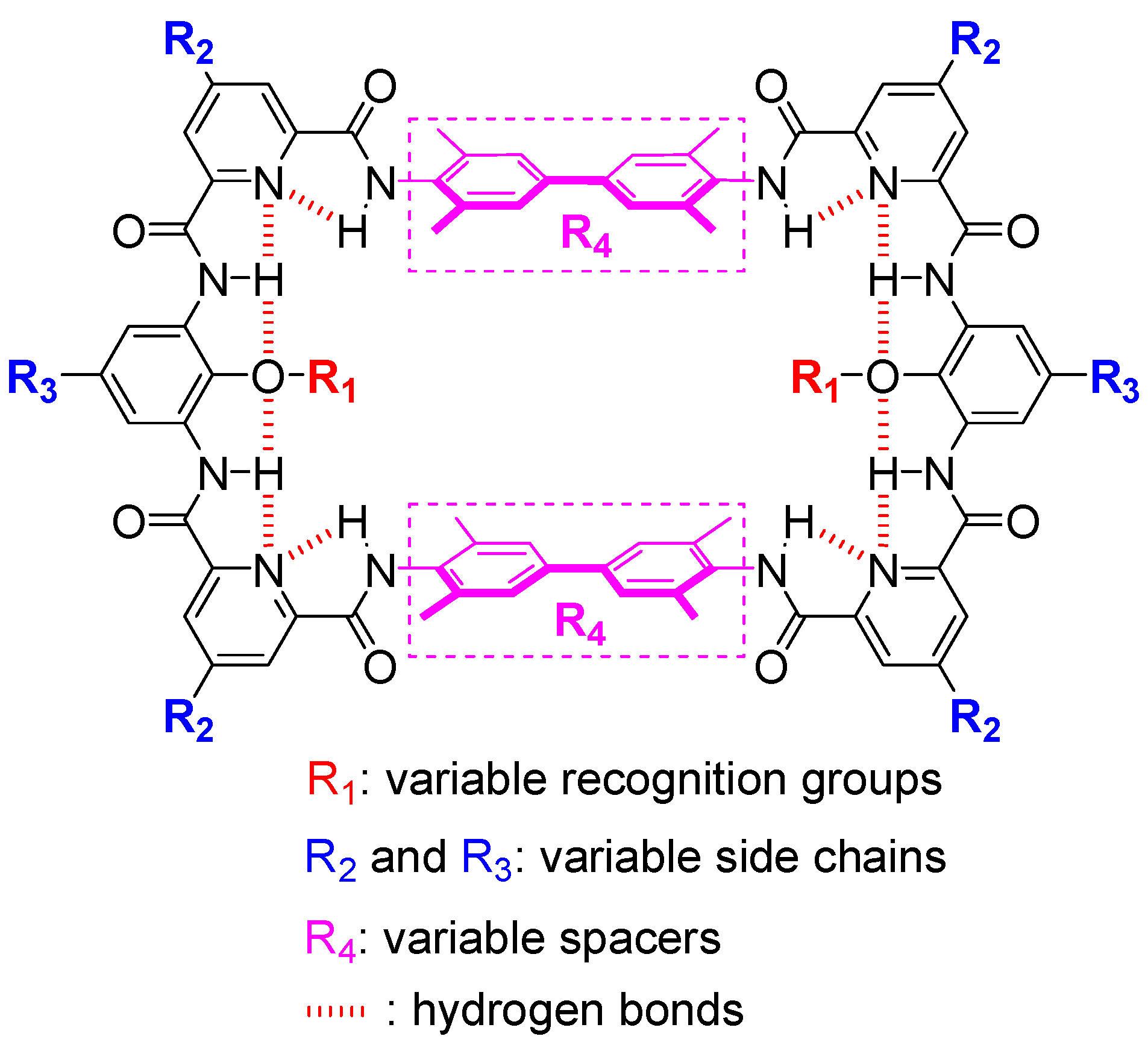
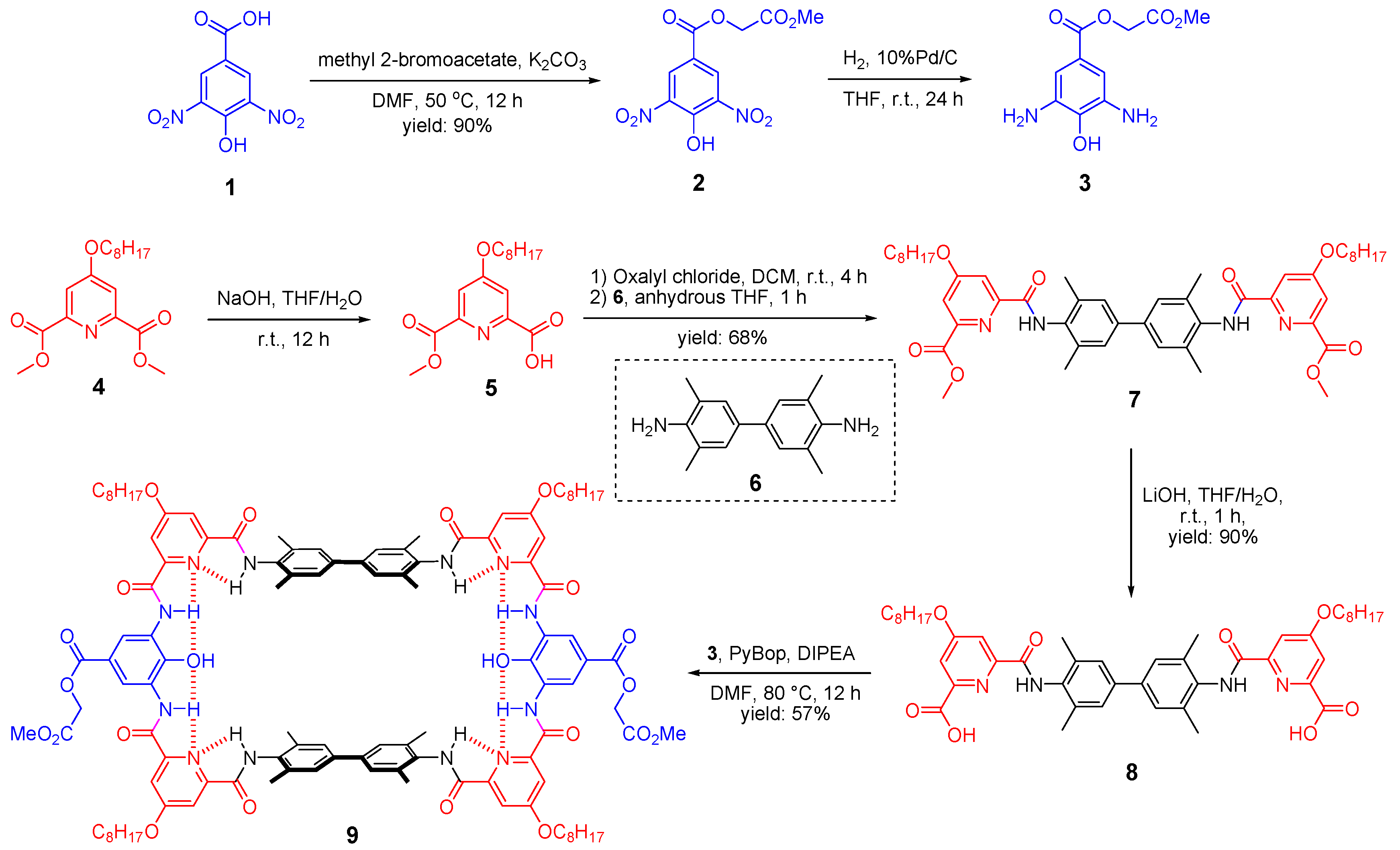
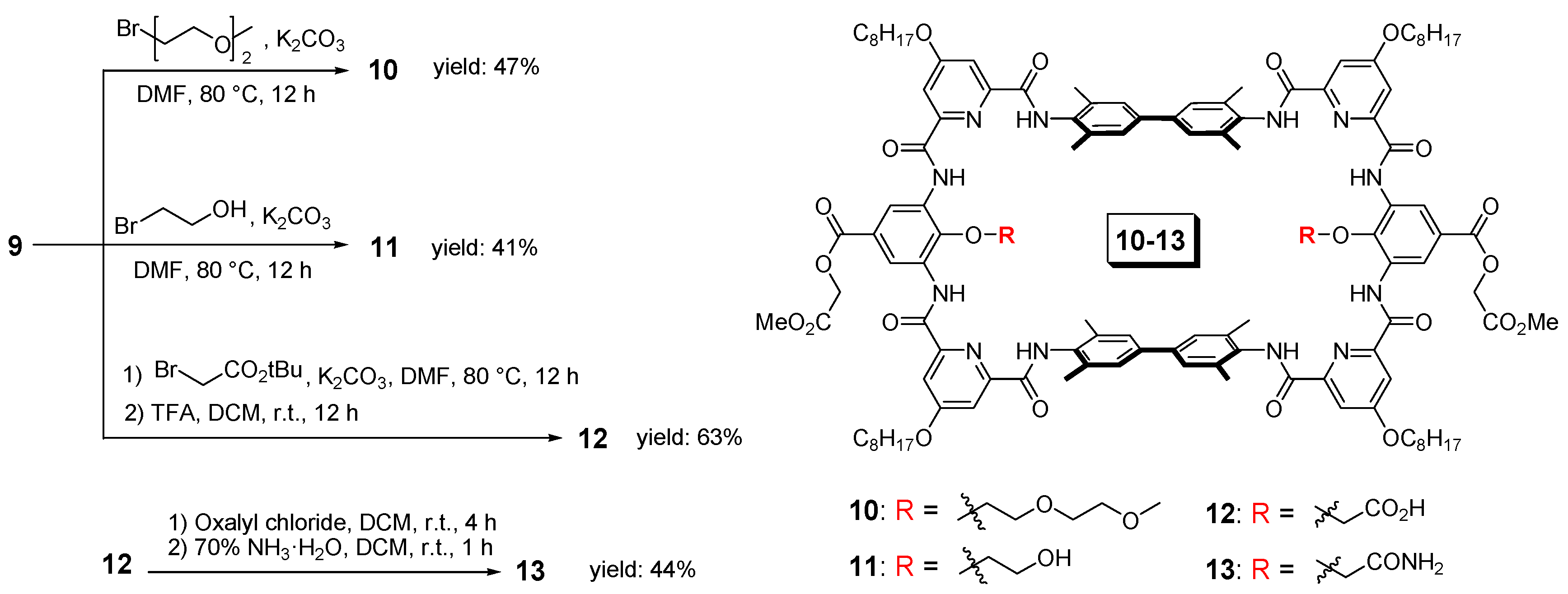
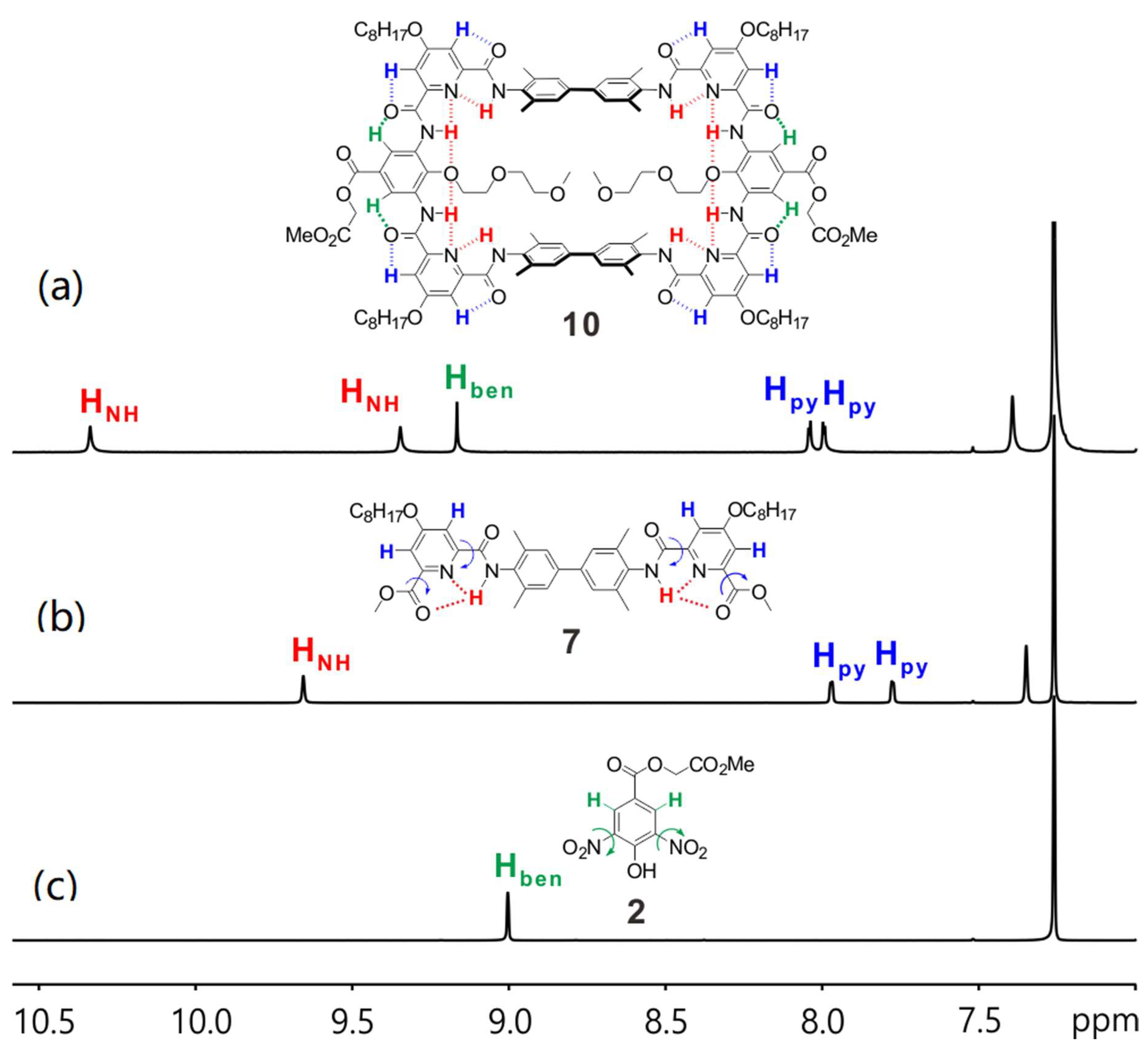
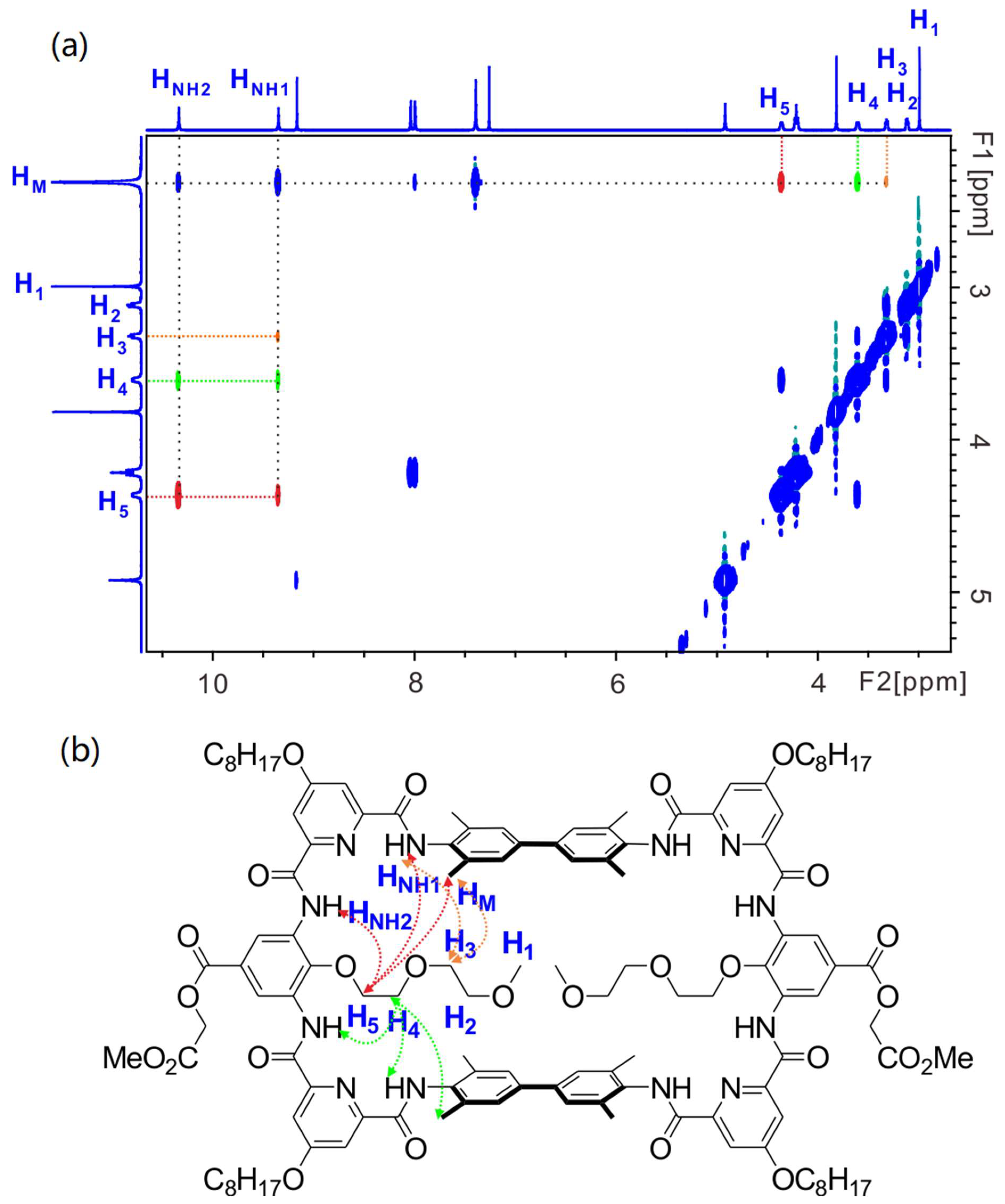
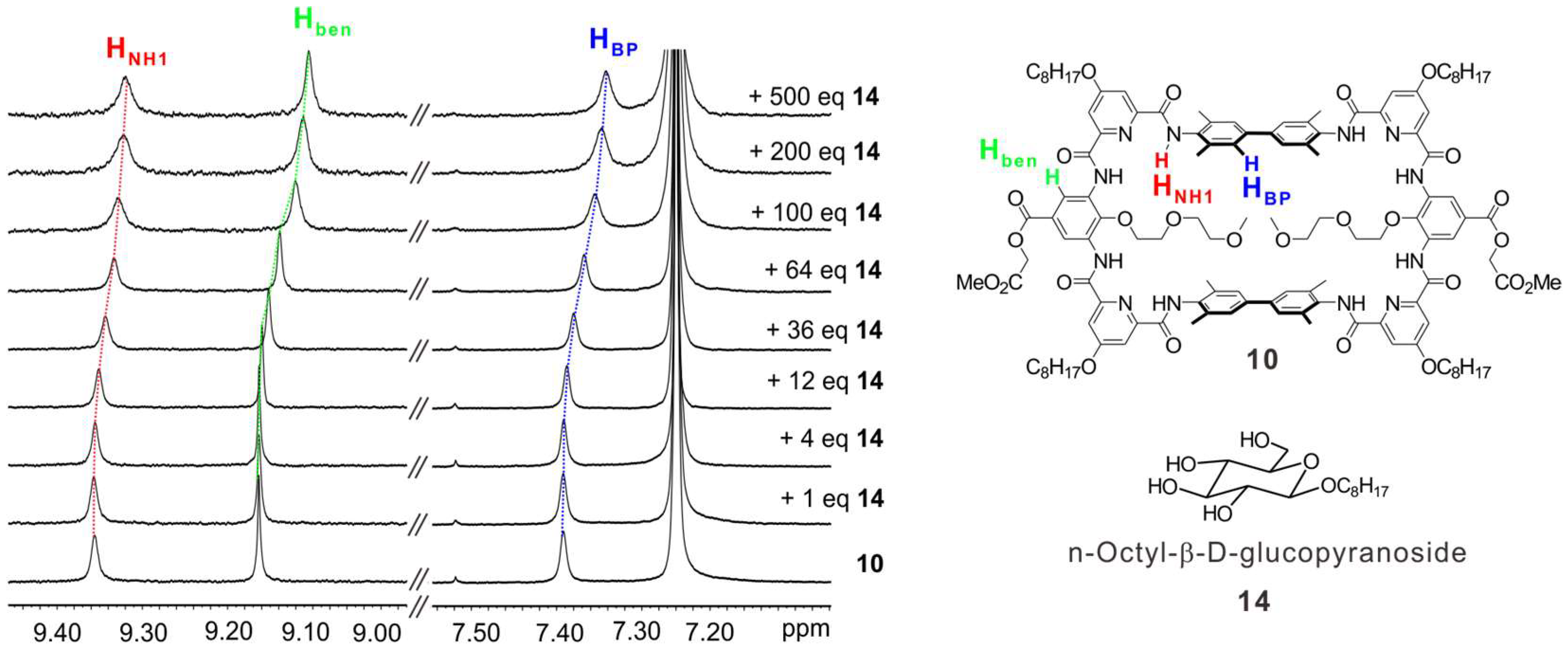
Disclaimer/Publisher’s Note: The statements, opinions and data contained in all publications are solely those of the individual author(s) and contributor(s) and not of MDPI and/or the editor(s). MDPI and/or the editor(s) disclaim responsibility for any injury to people or property resulting from any ideas, methods, instructions or products referred to in the content. |
© 2023 by the authors. Licensee MDPI, Basel, Switzerland. This article is an open access article distributed under the terms and conditions of the Creative Commons Attribution (CC BY) license (https://creativecommons.org/licenses/by/4.0/).
Share and Cite
Fan, L.; Du, M.; Kong, L.; Cai, Y.; Hu, X. Recognition Site Modifiable Macrocycle: Synthesis, Functional Group Variation and Structural Inspection. Molecules 2023, 28, 1338. https://doi.org/10.3390/molecules28031338
Fan L, Du M, Kong L, Cai Y, Hu X. Recognition Site Modifiable Macrocycle: Synthesis, Functional Group Variation and Structural Inspection. Molecules. 2023; 28(3):1338. https://doi.org/10.3390/molecules28031338
Chicago/Turabian StyleFan, Linmeng, Min Du, Lichun Kong, Yan Cai, and Xiaobo Hu. 2023. "Recognition Site Modifiable Macrocycle: Synthesis, Functional Group Variation and Structural Inspection" Molecules 28, no. 3: 1338. https://doi.org/10.3390/molecules28031338
APA StyleFan, L., Du, M., Kong, L., Cai, Y., & Hu, X. (2023). Recognition Site Modifiable Macrocycle: Synthesis, Functional Group Variation and Structural Inspection. Molecules, 28(3), 1338. https://doi.org/10.3390/molecules28031338



